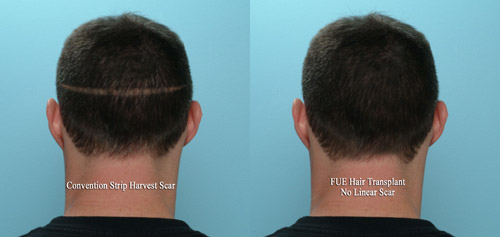Follicular Unit Transplantation & Extraction
 Follicular unit transplantation and follicular unit extraction (FUE, also known as the FOX Procedure) are recent and widely discussed surgical procedures for hair restoration.
Follicular unit transplantation and follicular unit extraction (FUE, also known as the FOX Procedure) are recent and widely discussed surgical procedures for hair restoration.
Follicular unit (FU) extraction is a procedure for obtaining follicular graft units from donor areas on the scalp. Follicular unit transplantation is the surgical procedure for transplanting follicular unit into the scalp.
The FU is identified anatomically as a small bundle consisting of 1 to 4 hair follicles, full-thickness as well as fine hairs, and the oil glands, muscles and connecting tissue that accompany and support hair follicles. If you look closely at the closely-clipped scalp from above as you would look at a wheat field from an airplane, you can see that scalp hair does not grow in even distribution like wheat in a field but rather in little groups of hairs that seems to be clumped together. These little groupings of hairs are called follicular units (FUs). When the scalp is examined under a magnifying glass or microscope, these FUs look like islands.
The “islands” are rooted at a level beneath the skin surface, called the mid-dermis. Identifying an individual FU can be difficult when follicles grow at angles under the skin and “surface” in the midst of neighboring FUs. The identification of FUs is done by the physician hair restoration specialist using a microscope. The identification, harvesting and transplanting of FUs requires the training and skill of a physician hair restoration specialist.
A recent development in surgical hair transplant surgery is to specifically use the FUs for transplantation. The FUs are removed from the donor site (usually on the nape of the neck) by using a harvesting technique that preserves the FU intact. One such technique is called single-strip harvesting and is done with a scalpel-like blade. Another method is called follicular-unit extraction (FUE). FUE is performed by using a punch-like “circular scalpel” to score the skin and mid-dermis to a level of about 2 millimeters around a follicular unit, then gently extracting the FU from within the scored circle.
The extracted FU may be used intact, or may be divided into smaller units for transplantation. Single follicular units are often used to fill in a hairline, multiple FUs to provide greater density in the center of the scalp. The FUs are transplanted into the scalp by inserting them into small slits incised into the skin and underlying tissue with a small blade or needle.
There has been debate regarding the scarring left at the donor site by harvest of FUs. Single-strip harvest leaves a single, fine incision that usually heals in a few days. Follicular unit extraction (FUE) leaves small holes 1 to 2 millimeters in diameter at the site of FU extraction. These holes are not stitched but are rather left to heal on their own. Proponents of the FUE procedure claim decreased or complete lack of scarring but others have cautioned that in some patients these extraction sites may leave dimpled white spots similar to a golf ball.The choice of harvesting techniques should be made after discussion between patient and physician.
Follicular unit transplantation is a newer surgical technique that continues the modern emphasis on achieving a “natural” look from hair transplants. It is a technique that, like micrografting, uses 1 to 4 units to achieve an even distribution of hair coverage over the scalp and avoid the “row of corn” appearance that was common many years ago.
An additional advantage claimed for follicular unit transplantation is that FUs are the natural hair-bearing structure in the scalp, and transplanting them as units increases the likelihood of natural growth after transplantation.
The availability of FU transplantation expands the number of options a patient may consider for surgical hair restoration. Whether it is the best option for an individual patient depends upon the individual patient characteristics, including cause of hair loss, type of hair loss, likelihood of hair loss progression over future years, cost of procedures the patient may consider, and the patient’s wishes for the “look” that he or she wishes to achieve from hair restoration.
Courtesy of International Society of Hair Restoration Surgery
